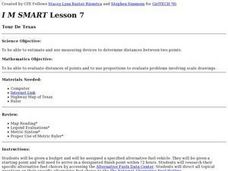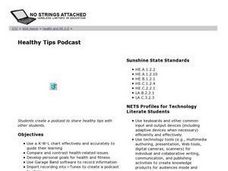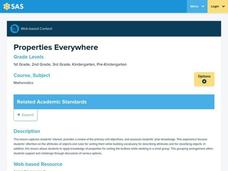Curated OER
Thoreau and those he influenced
Eleventh graders work in groups and research assigned person using the internet and use print resources for DHS media center. They create a poster that shows possible connections to H.D. Thoreau's writings and philosophies, a short...
Curated OER
Welcome Bags
Students identify ways to make new students feel welcome. In this new students lesson, students work with school guidance counselors to identify ways to welcome new students to their school. Students create welcome bags for the new...
Curated OER
The Governors General of Canada
Students create and edit a website on Canada's Governors General. They identify the role and responsibilities of the office of Governor General, and write biographies on the previous Governor Generals.
Curated OER
Tour De Texas
Young scholars are given a budget and an alternative-fuel vehicle. Using a map of Texas, they are given a starting point and determine how to arrive at their destination within 72 hours. They use the internet to research the...
Curated OER
Friends, Romans, Countrymen...
Pupils research various facets of the Ancient Roman Empire including art and history. They write a research driven paper documenting the facet of the Roman Empire they have chosen.
Curated OER
Accounting -- Forming and Solving Business Organizations
High schoolers review what a proprietorship is and the advantages and disadvantages of it. In groups, they examine the ways to form and dissolve a proprietorship. To end the lesson, they review what a corporation is, its advantages and...
Curated OER
Healthy Tips Podcast
Learners create a health-based podcast for peers using prior knowledge, internet research, and KWL charts. This lesson is adaptable for different health topics and age levels.
Pennsylvania Department of Education
Multiple Patterns
Students explore patterns that involve doubling numbers. In this multiple patterns lesson, students use objects to explore these patterns while recording them using a table. Students recognize even and odd number patterns while applying...
Pennsylvania Department of Education
What Balances?
Students explore another meaning of subtraction as it pertains to the inverse of addition. In this what balances activity, students identify the concept of subtraction as a balance. Students use subtraction facts to generate addition...
Pennsylvania Department of Education
Properties Everywhere
Students examine and sort objects by specific attributes and apply prior knowledge. In this properties everywhere activity, students work in groups to arrange objects in categories then discuss various sorting options while...
Pennsylvania Department of Education
Links Away: Looking Back and Moving Forward
Students explore fact families. In this math lesson, students use links to model a fact family. Students solve addition and subtraction problems.
Curated OER
Rock On
Fourth graders create a powerpint presentation to inform their classmates about a selected type of rock. Students are divided into groups to research a particular type of rock. Each group researches their topic using traditional and...
Curated OER
What's Up with Waste?
Fifth graders design a brochure that identifies types of solid waste that are often improperly disposed, explains the effects of this disposal and proposes a solution to the problem. The read humorous books, define vocabulary words and...
Curated OER
Presidential Campaigning
Eighth graders participate in a simulated presidential campaign by conducting research on the Internet. They define a party platform, run a campaign and write and deliver speeches in teams. Students can then act as the electoral college...
Curated OER
Bon Voyage - Literature Travel Unit
Eighth graders locate and interpret information about the culture of another country using multi-media tools. Students read and interpret literature about characters and cultures from a foreign country. Students create a travel guide...
Curated OER
Destructive/Constructive Communication
Young scholars are introduced to the characteristics of destructive and constructive communication. In groups, they send I-messages to other groups of examples of each. To end the lesson, they participate in role-play activities to...
Curated OER
Social Studies: A Ticket to Japan
Fourth graders create Venn diagrams to compare and contrast life in the United States and Japan. While the teacher holds up word cards, they decide where to categorize them under Japan, the U.S., or both. As students assemble their...
Curated OER
Making Waves, Making Music, Making Noise
Sixth graders watch a demonstration on how talking cans produce sounds. In groups, they compare and contrast the sounds from different sized cans. They participate in a variety of activities to discover how sounds are made and how...
Curated OER
A Pocketful of Change
Students study the meaning, symbolism, and value of U.S. coins,
especially the quarter. They conduct a survey of coins in students'
possession, graphing the results to show frequency distribution and drawing
inferences about the U.S....
Curated OER
Religion, Culture, and Diversity
Students study different religions and share their own religious traditions. In this religion lesson, students investigate different religions and how ideas about religion can create conflict, growth, and change. They interview family...
Curated OER
Making Books
Students make a variety of books using the computer program iPhoto and digital images of their choosing. This lesson for the upper-elementary classroom includes an example of student work and four possible lesson extensions and...
Curated OER
Line Best Fit
Students identify the line of best fit. In this statistics lesson, students analyze graphs and plots to identify positive, negative or no correlation. They find the line of best fit for different scatter plots.
Pennsylvania Department of Education
Some Special Sums
Students study addition. For this math lesson, students solve doubles and doubles plus one addition facts. Students roll dice and use the numbers to create addition problems.
Pennsylvania Department of Education
Eye to Eye
Students practice the concept of posing mathematical questions regarding themselves and their surroundings. In this eye to eye lesson, students gather data about eye color from their classmates. Students organize their data in order to...























